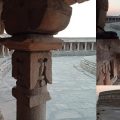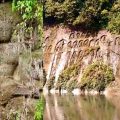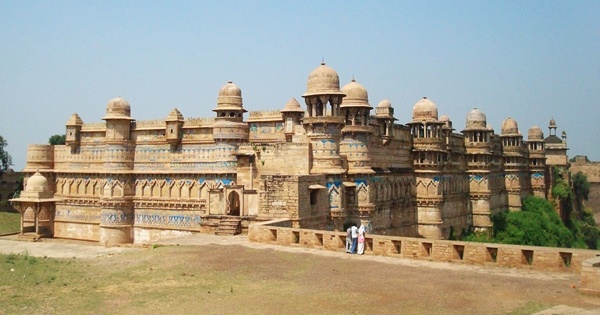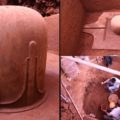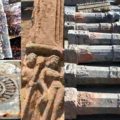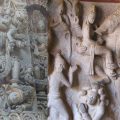Morena Golden Triangle Temples: Remnants of a 8th-15th Century University
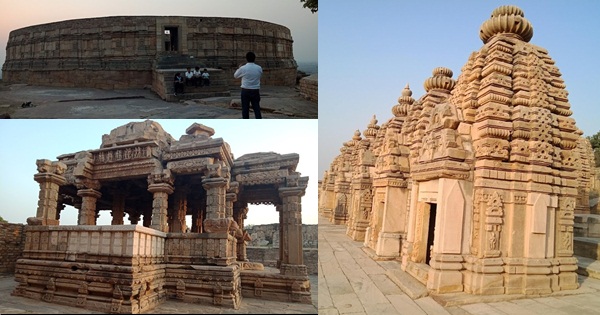
Morena! This city in the Chambal division of Madhya Pradesh was a hub of university education once upon a time. Temples from the 8th to 12th century abound in this region. The very utterance of the term ‘Chambal’ may transport you to the terrain of Baaghis or to say ‘terror of dacoits’ as highlighted in cinema and media. The forts and temples in this region that have survived destruction by Islamic invaders and the ravages of time speak volume about the lost splendor of the bygone days. Morena is home to the Golden Triangle temples that housed a university since 8th century. The Bateshwar group of temples, Chaunsath Yogini, and Garhi Padavali form the Golden Triangle temples.
An inscription found in the Chaunsath Yogini temple in Mitavali mentions about Mitavali, Padavali and Bateshwar temples as a Golden Triangle within which a famous university existed. These three places in Morena hosted learning centres for different subjects. At the Chaunsath Yogini temple, Astrology and Mathematics were taught. Teachers banked upon the rays and shades of the Sun for certain calculations! The rays of the sun fell in the temple in distinct designs and patterns given the circular structure. Bateshwar temples were the centre, the nucleus of the Golden Triangle University.
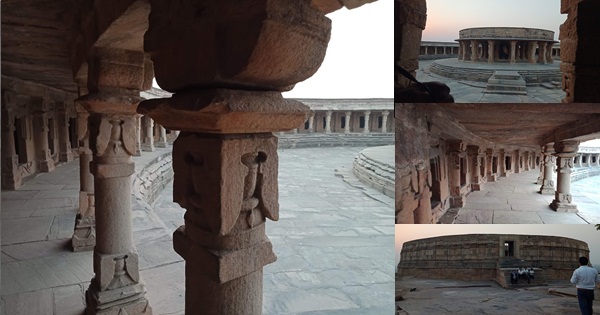
Chaunsath Yogini temple in Mitavali
The Bateshwar temples are a group of around 210 small and big temples. Another 150 temples are yet to be excavated in and around the area. The theme of the art and sculpture in these temples is diverse, which suggest this centre taught temple related arts and sculpture including the art of building temples. The sculpture motifs range from the Dashavatar carved in many a lintel that opens to the Garbhagriha to description of Navagrahas, Saptamatrikas, and more. A blend of Shaktism, Shaivism, and Vaishnavism is clearly visible in the sculptures of the Bateshwar temples.
Gerd Mevissen, an independent researcher from Berlin, who specialises in epigraphy of temples, also suggests that Bateshwar temples site was ‘once a hub for temple-related arts and artists’. Most of the temples that depict a fusion of different temple building styles suggest that artists and students fused and experimented with a variety of temple building ideas. The premise of Garhi Padavali complex is huge, which speaks volume about the learning centres it must have housed and the students and teachers it must have accommodated.
Carvings of Dashavatar in one of the lintels of a small temple in Bateshwar site
How was education imparted down the ages? Since thousands of years, thousands of Rishis chanted mantras and hymns and stockpiled the powerful positive energies in the atmosphere around. These were handed down from one generation to another through memorization by word of mouth. The Rishi, also the Guru who imparted the knowledge to his shishyas or sons, continued with this tradition through remembrance. For hundreds and thousands of years before the Vedas were compiled, they were sruti (what is heard). This is the reason why when one listens to Sanskrit chants from the Vedas and other scriptures, the positive energy is added and the aura around further energized. Each Rishi, who imparted knowledge, symbolized a Vedic school in the true sense in ancient times.
In later Vedic period and during the Mahabharata era, students in groups, stayed at the Guru’s ashrams until their education was completed. Bigger Gurukulas served as universities, i.e. centres of higher education. For example, Takshashila University, founded by Duryodhana in the Mahabharata era, enrolled students for higher studies. Chanakya was a student of this university. Thereafter, in addition to Gurukulas and universities, temples and mutts emerged as learning centres.
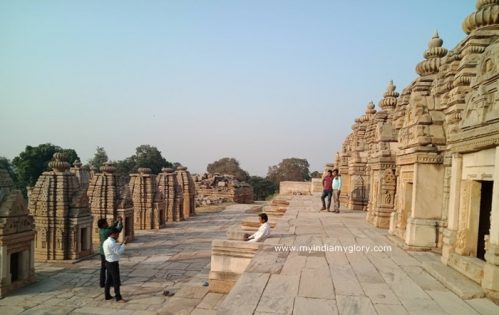
Bateshwar temples
Preservation of ancient culture, study of the scriptures, character building, development of personality, religious duties, inculcation of the spirit of individual roles towards family and society, discipline and self-dependence were the key factors considered while imparting education. Though thousands of temples and educational institutions were destroyed by Islamic invaders, the concept of temple education declined to some extent but not fully. The educational flame was kept alive. Under Islamic rule, the temples which were earlier run under the patronage of the rulers, were then supported by the local Hindu population. According to the book The Beautiful Tree by Shri Dharampal, temples were not only the centres of primary education for all Varnas but also a nuclei of important social, economic, artistic and intellectual functions. Let us delve on the Golden Triangle temples in detail.
Mitavali Chaunsath Yogini Temple
The Chaunsath Yogini Temple in Mitavali is located on a hillock, which is about 100 feet in height. It is also called Ekattarso Mahadeva Temple by the localites. One has to climb around a flight of 100 steps to reach the shrine. The Indian Parliament House has been designed according to this temple. There are architectural similarities between the two. Both are circular shaped. While the temple was built during the 8th century, the Parliament building was constructed during 20th century. The temple has a big circular temple at the centre surrounded in a semi circular manner with 64 temples within the bigger circle. Similarly at the centre of the Parliament building is the central chamber surrounded by semicircular halls. While the temple has over 100 pillars, the Delhi building has 144 pillars.
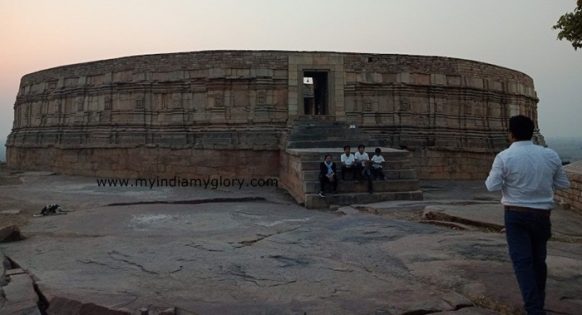
Chaunsath Yogini temple in Mitavali
The entrance of the Chaunsath Yogini Temple opens towards the east. This circular shaped temple, at a radius of 170 feet, contains small cells against a pillared verandah in a circle around the main shrine – an open mandapa in the centre. Each of the 64 cells has a mandapa. The cells and the mandapa are separated by a circular shaped courtyard. The main shrine at the centre is placed on a raised circular plinth. The Garbhagriha has a Shivalinga. The roof of the entire structure is flat.
There are slab coverings with perforations in them within the main central shrine. It facilitated draining of rainwater to a large underground storage. The roof has pipelines for flow of rain water to the same underground storage. Carvings of Hindu deities depict the exterior surface of the outer wall. The Chaunsath Yogini temple originally housed Yoginis and as the deities were missing, later rulers who renovated the temple added the Shivalingas in their place.
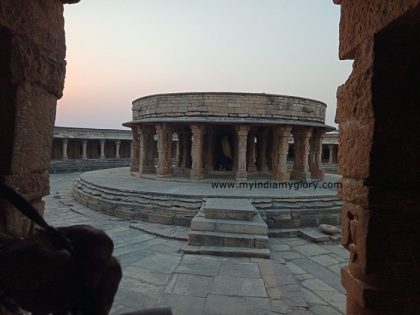
Inner circle of Chaunsath Yogini temple in Mitavali
Garhi Padavali
A majestic pair of lion and lioness standing guard at the entrance of the towering fort of Garhi Padavali welcomes every visitor. A steep flight of stairs will lead you directly to the temple in a compound. At Padavali there existed an ancient temple of Mahadev. Few attribute it to Vishnu and few to Surya Dev. It had a garbhagriha (sanctum sanctorum), mandapa, and mukhmandapa. The original structure was in ruins. Probably it housed three temples, each dedicated to Mahadev, Vishnu, and Surya Dev.
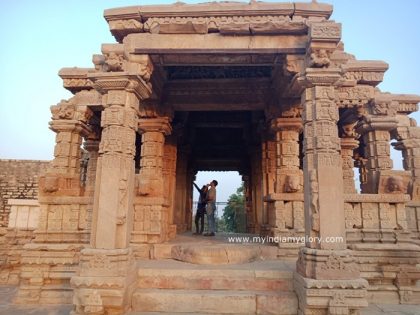
Garhi Padavali temple
With the structural ruins of the temples, the present fort was constructed retaining the original temple within, later by the Jat Rana rulers of Gohad. They used pieces of the fallen temple ruins in raising the walls. These pieces are visible in the walls of the fort at various places. The temple cum fort complex is huge, which speaks volume about the learning centres it must have housed and the students and teachers it must have accommodated. The temple was built in between the 8th to 10th centuries.
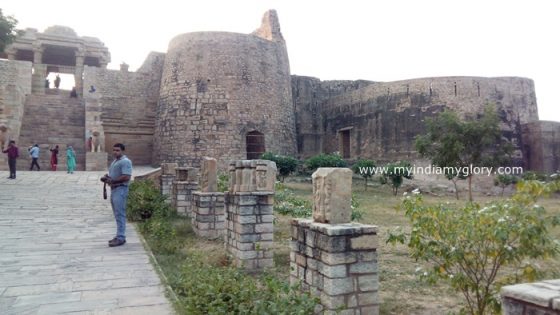
Padavali fort and temple; one part of the Golden Triangle University
The intricate carvings of deities, Gandharvas, and Apsaras in the ceiling of the ‘larger than life’ mukhamandapa of the temple are a feast for the eyes. These carvings narrate stories from the Ramayana, Mahabharata, Puranas. Through art, the gifted artists have depicted Samudra Manthan, the trinity of Brahma, Vishnu and Mahadev, Ganesha’s wedding, Krishna Leela, dancing Shiva, Dashavatar, and lots more including erotic carvings.
Every inch of the pillars, lintels, beams, and the ceiling has a story to tell! They tell the whole story of an ancient civilization of India, from mythology to ancient history in the minutest detail! And you can keep staring at the intricate profusion of carvings for hours!! Probably students of the Golden Triangle temples learnt the art of carving at this site.
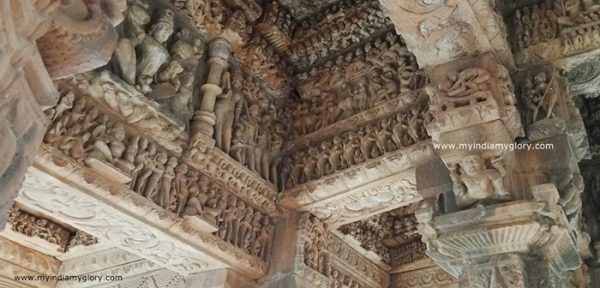
Carvings in the ceiling of the temple in Garhi Padavali
The eastern wall of the compound has double-storied cells, which indicate the happening of military activities once upon a time. A deep well like baoli adorns the southern corner.
Bateshwar Temples
Bateshwar draws its name from Bhuteshvar temple, the largest temple of Mahadev at this site. This place finds mention in historical texts as Dharon or Paravali and later as Padavali. As aforementioned, 210 small and large temples have been excavated and another 150 temples are yet to be excavated. These temples, dedicated to Mahadev, Vishnu, and Shakti, are spread across 25 acres in a hill. Most of these temples were completely in ruins out of which 80 temples were restored by the ASI under Superintending Archaeologist KK Muhammed, who calls the site as his place of pilgrimage. Few of the temples here were restored under supervision of Archaeologist Ashok Kumar Sinha.
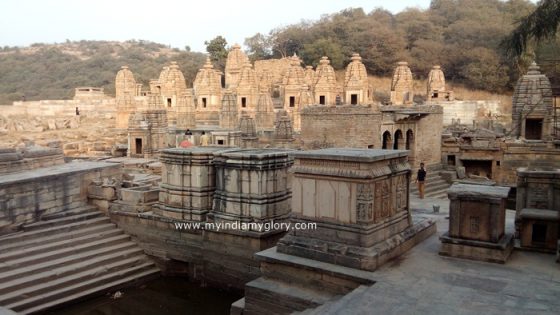
Bateshwar temples
There are around 364 Shivalingas at this site with over a 100 adorning the garbhagrihas of the temples. According to our guide at the site, worshipping of this Shivalinga and the main Shivanlinga of the temple has been continuing since hundreds of years. All Shivalingas date back to 8-10th centuries or beyond. A Panchmukhi Shivalinga adorns one of the temples. The temple architecture and designs conform to rules mentioned in two ancient Indian Vastu texts – Manasara Shilpa Shastra and Mayamata Vastu Shastra.
The site has a water tank cut into the hill rock. Rows of small temples adorned both sides of the pathway leading to the tank once upon a time.
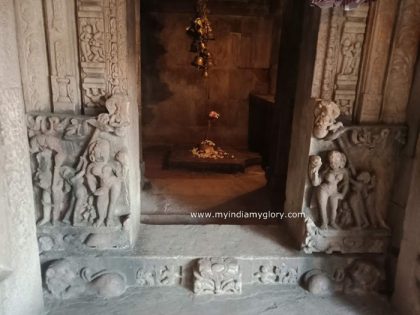
Main shrine where the Shivalinga has been worshipped since centuries
The temples were destroyed by Islamic invaders. The ravages of time and weather conditions further worsened the conditions. Later, Gurjar baaghis led by Nirbhay Singh Gurjar protected the site from being looted by heritage thieves. The temple complex had also come under threat from illegal mining and the associated use of dynamite. Nirbhay Singh Gurjar and and his gang helped the ASI restore the temple complex. A news report published in The Hindustan Times quoted, “ASI officials say that Nirbhay Gujjar and his gang provided much help for the restoration work until the dacoit was killed in 2005 in an encounter with the police. In another couple of years, all the dacoits were either eliminated or surrendered.”
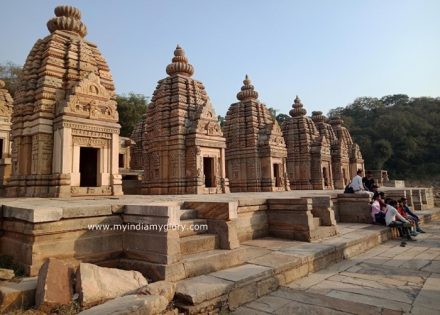
Bateshwar group of temples
Who built the Golden Triangle temples? The Golden Triangle University did exist as corroborated by the inscription at the Chaunsath Yogini temple. And if Bateshwar temples were built between 8th to 10th centuries by the Gurjar Pratihars, both the Padavali temple and Chaunsath Yogini temple must have been built by the same dynasty during the same time. Because these three places formed the Golden Triangle and all these three places are located at Morena within a distance of only a few kms. The Padavali temple was later renovated by the Kachchhapaghata rulers and then by the Jat Rana rulers of Gohad.
Few attribute the dating of the Chaunsath Yogini Temple in Mitavali to the 8th century, while few claim it was built in the 10th century. A section of scholars mention 14th century, the date of an inscription found in the temple premise, as valid. The 14th century assumption is completely baseless, as the structure of the temple dates much earlier. The inscription mentions Maharaja Devapala and his wife as the patrons, but doesn’t mention which dynasty the king belonged. It is dated Vikrama Samvat 1380, corresponding 1323 CE of the Gregorian calendar. The epigraph must have been inscribed later, as another epigraph dating 16th century is also found in the same premise.
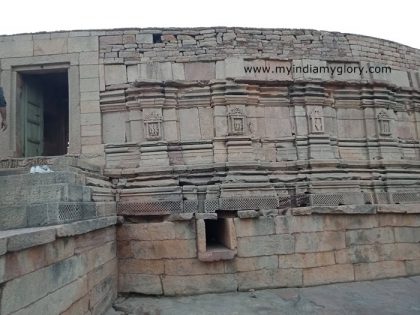
Exterior walls of Chaunsath Yogini Temple
The slab by ASI at the site containing info about the temple mentions 1323 CE as the date of construction, i.e. the date of inscription. Most inscriptions at different sites described events that happened at earlier dates. For example, the Rannod inscription described about events related to kings, visitors, and sages of Kadwaha Mutt that happened years ago including attack and destruction of the Mutt and temple by Alauddin Khilji in 1309 CE. To cite another example, Kaluvacheru inscription of 1423 portrays the Musunuri Nayakas as legitimate successors to the Kakatiyas. And there were two Musunuri Nayakas who were rulers – Prolaya Nayaka who ruled the Godavari region from 1325 and his successor Kapaya Nayaka who ruled from 1333. Hence, 1323 CE cannot be the date of construction and there was no ruler by the name of Devapala, who ruled the region during this period.
Who was Devapala? While few scholars attribute Devalapa as the Pala king of Bengal, few mention him as a Kachchhapaghata king and few term him as a Gurjar Pratihar. As per historical records, there was a Gurjara Pratihar ruler called Devapala, who ruled from 948 to 954 CE. Records also corroborate Devapala as a Kachchhapaghata king, who ruled from 1055 to 1085 CE. Historical records mention Kachchhapaghata as a vassal of the Gurjar Pratihars.
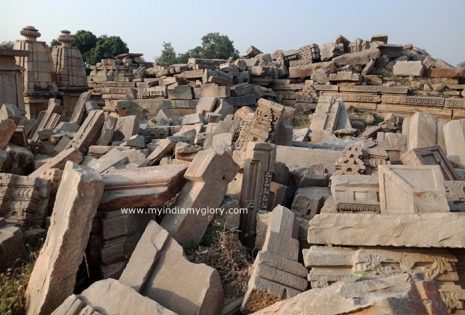
Ruins in Bateshwar temples site
Pala king Devapala ruled Bengal, Bihar, and parts of Orissa during the 9th century. He was a staunch follower of Buddhism. Under him numerous Buddhist temples and monasteries were constructed in Magadha and other cities. Hence, claim that Devapala of Bengal built the Morena 64 Yogini temple is completely groundless; he would not build a temple dedicated to Mahadev or the 64 Yoginis.
Rama S Tripathi’s book History of Kanauj: To the Moslem Conquest mentions about inscriptional evidence of Devapala as a Gurjar Pratihar ruler. According to Khajuraho Inscription No II, Devapala was the contemporary of Chandela king Yasovarman. While Devapala ruled from 948 to 954 CE, Yasovarman ruled from 925 to 950 CE. Devapala gifted an idol of Vaikuntha to Yasovarman by force. The idol of Vaikuntha was originally acquired by the Raja of Bhota (modern Tibet) from the Kailash mountains. The Tibetan king gave this idol as a gift to the king of Kira (while few deem Kira to Kangra Valley, few consider it to be Kashmir). Devapala obtained this idol from the Kira king against a force of horses and elephants. Ultimately Devapala had to gift the idol to the Chandela king against his wishes.
It was from Devapala’s time that the Gurjar Pratihar dynasty started seeing a decline. The 10th century (960 CE) Rajor Inscription of Alwar mentions about Vijaypala as the ruler of Kannauj in 959 AD. Kannauj was the capital of the Gurjar Pratihar rulers. Vijaypala was either the brother or half-brother of Devapala. Vijaypala must have been the immediate successor of Devapala. Devapala’s predecessor Mahendrapala II reigned for a short duration, i.e. from 944–948. The Mandasor inscription mentions about the Gurjar Pratihar empire extending up to Mandasor during Mahendrapala II’s reign.
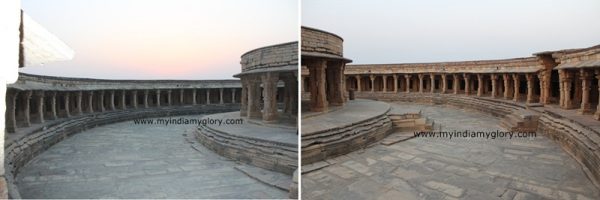
Inner circle of Chaunsath Yogini Temple
Hence, Devapala who built the Chaunsath Yogini temple as corroborated by the inscription was either the Gurjar Pratihar king from 10th century or the Kachchhapaghata king from 11th century. The inscribed date 1323 CE is the timeline when the temple was renovated. It is even possible that the temple was constructed in the 8th century and it underwent several renovation works until the inscribed date of 1323 CE.
Morena and the adjoining regions were under attack by Islamic invaders, who plundered and destroyed the temples. Islamic invaders also destroyed several universities including Nalanda and Vikramshila. Nalanda University was destroyed by Bakhtiyar Khilji in 1193. It had three multi-storey libraries that stored millions of manuscripts. Khilji set fire to the libraries and the manuscripts burnt for several months as per an account by Persian historian Min-haj-e-Siraj. In all probability the Golden Triangle temples that housed the university must have faced a similar fate.
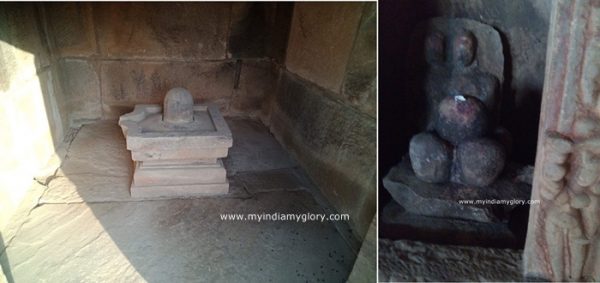
Shivalingas (on the right is the Panchmukhi Shivalinga) at Bateshwar temples
The above research article is based on site visit by the author (Manoshi Sinha) with Yogaditya Singh Rawal.
Part Ref:
1. History of Kanauj: To the Moslem Conquest, Rama S. Tripathi
2. Figurations of Time in Asia, Dietrich Boschung, Corinna Wessels-Mevissen
3. The Beautiful Tree by Shri Dharampal
4. ‘Construction and Conception: Maṇḍapikā Shrines of Central India’, East and West, Vol. 26, Michael W. Meister.
All images clicked by author and Yogaditya Singh Rawal.

